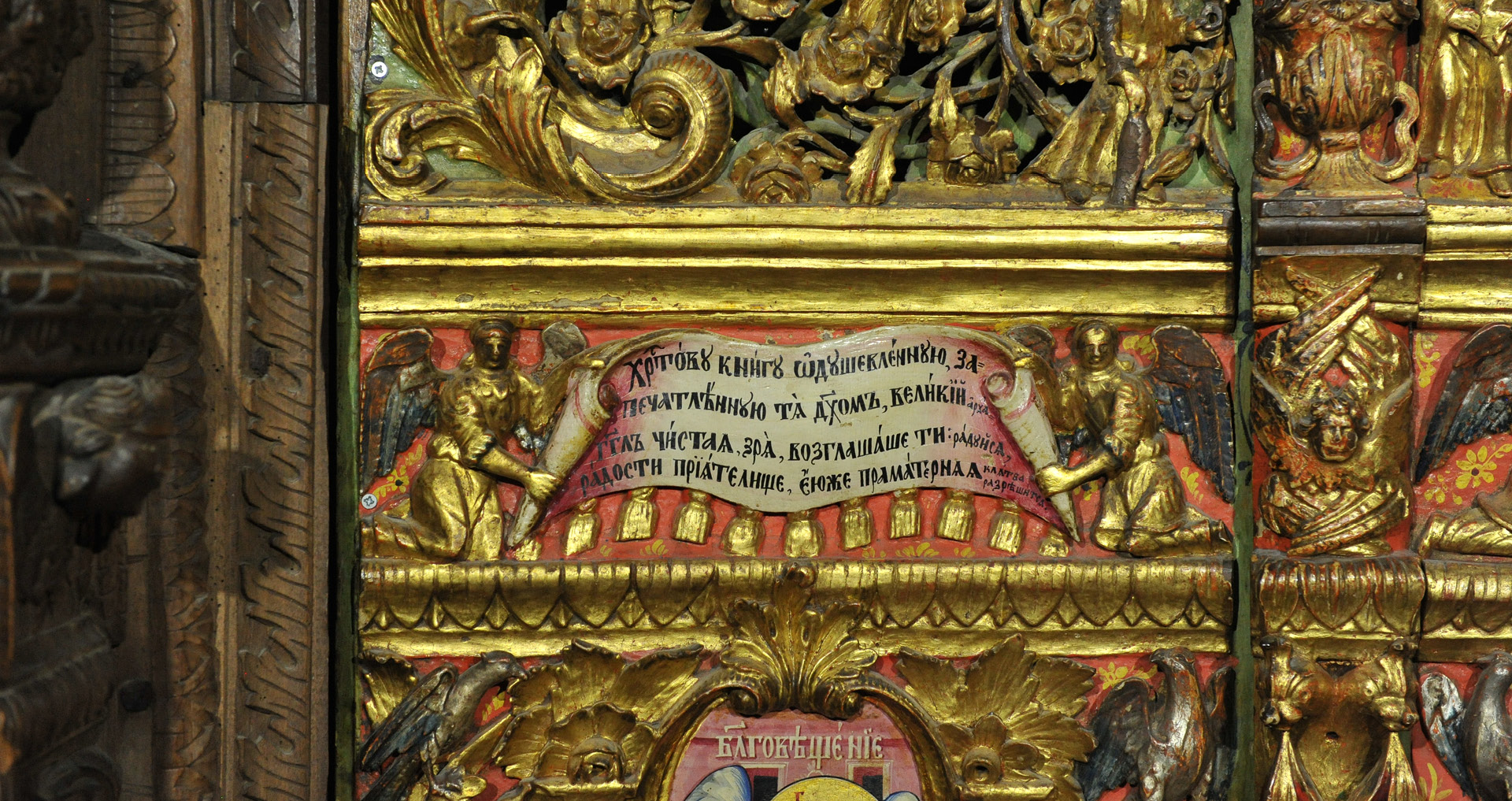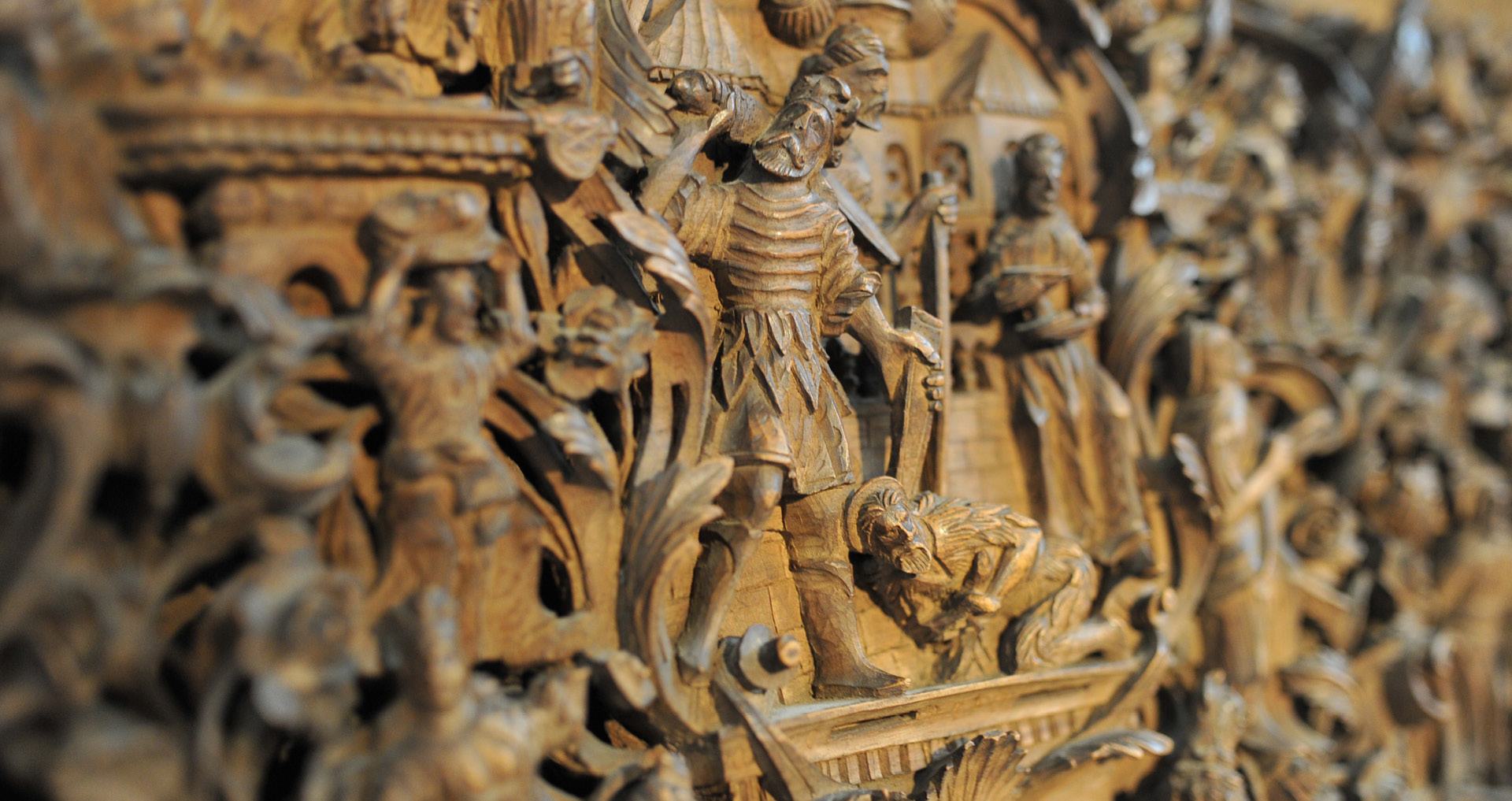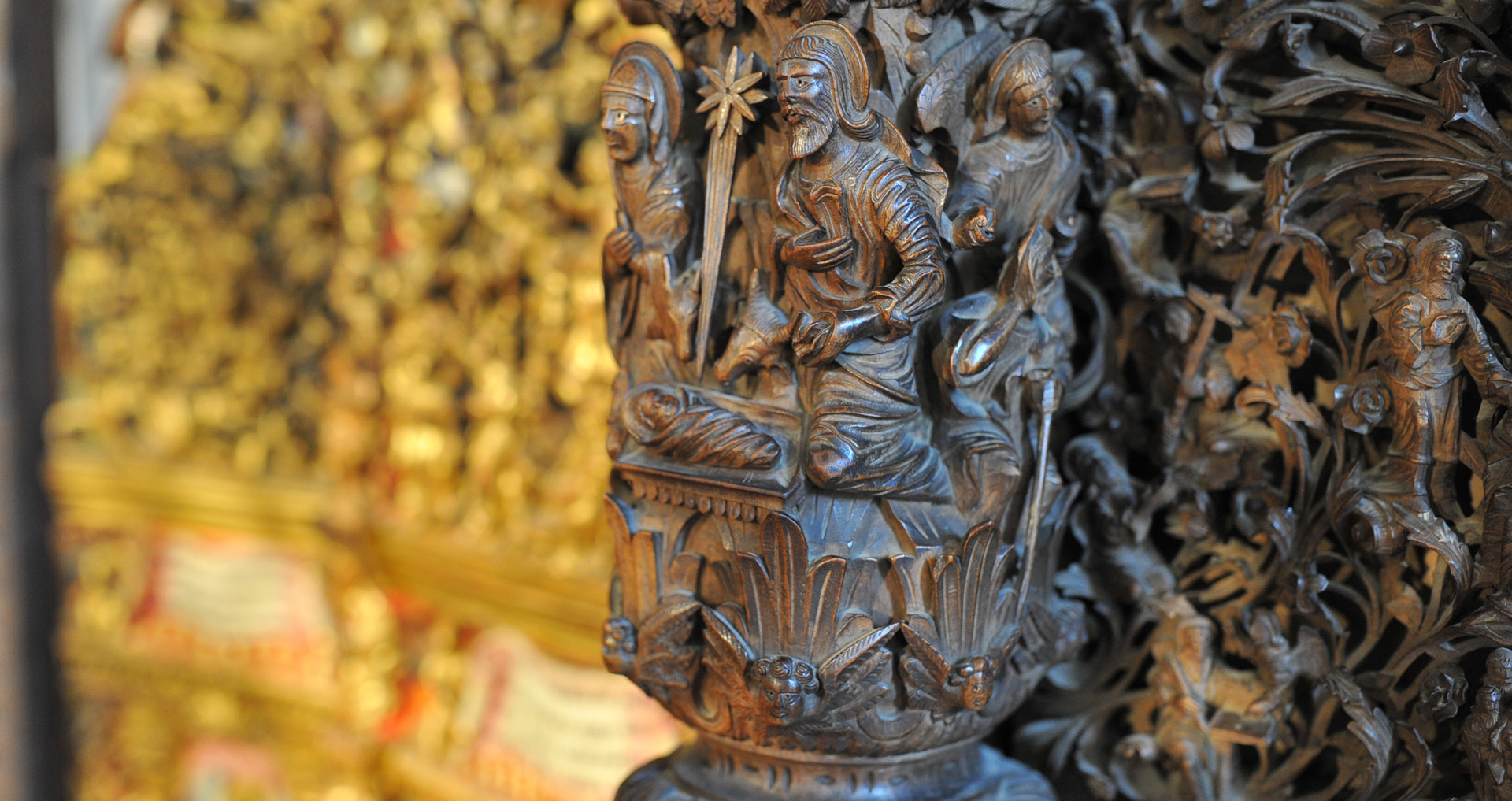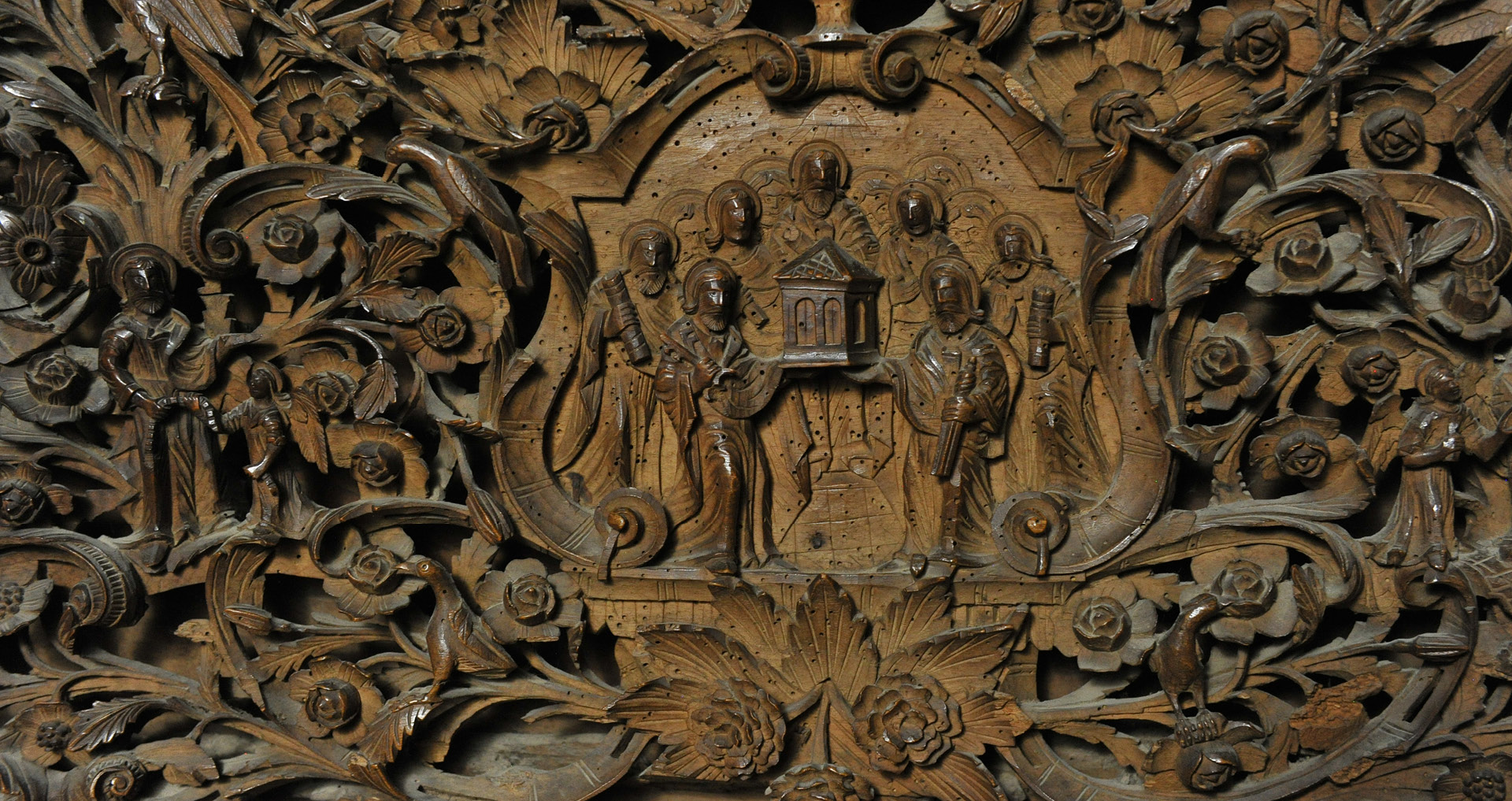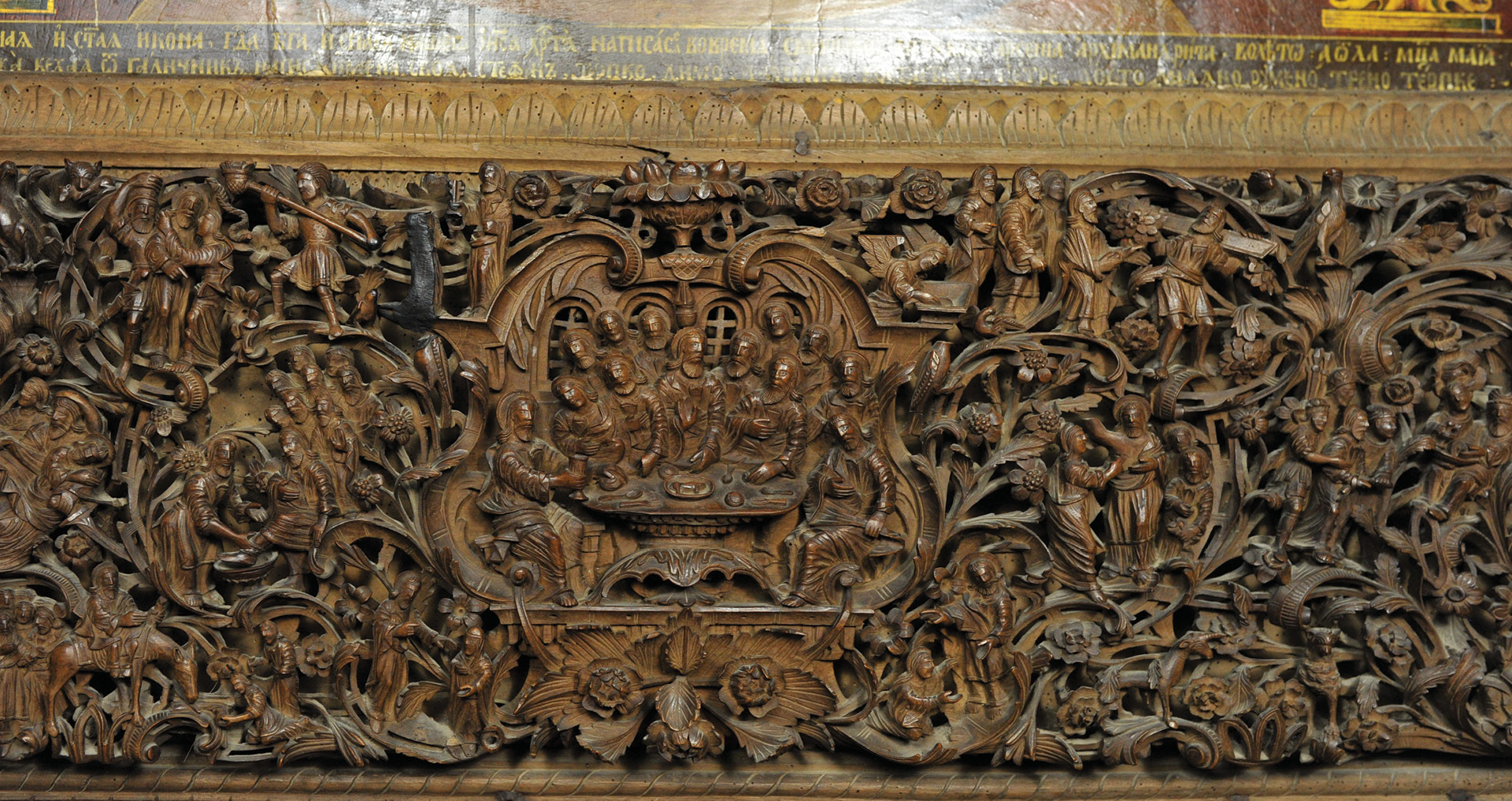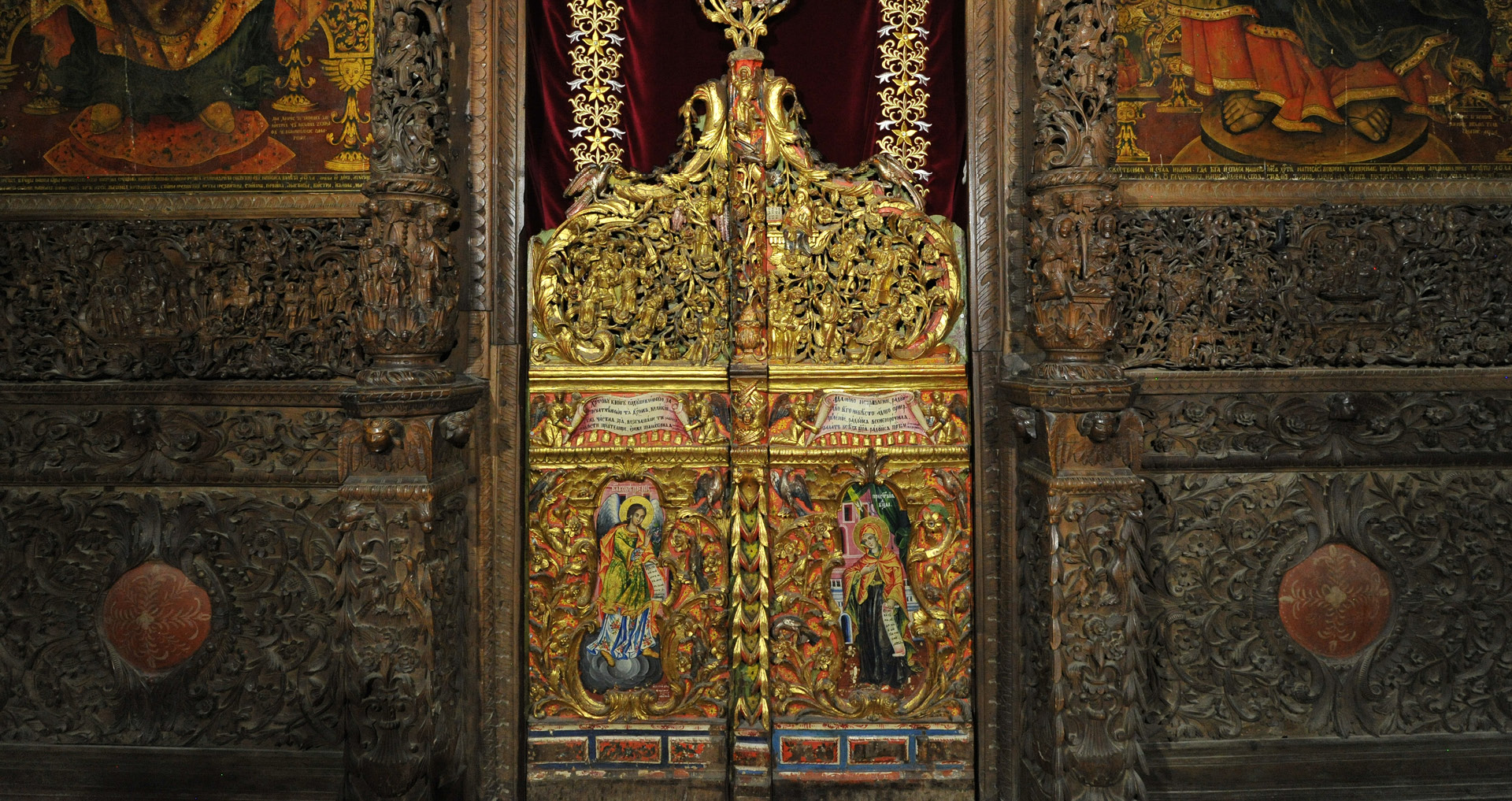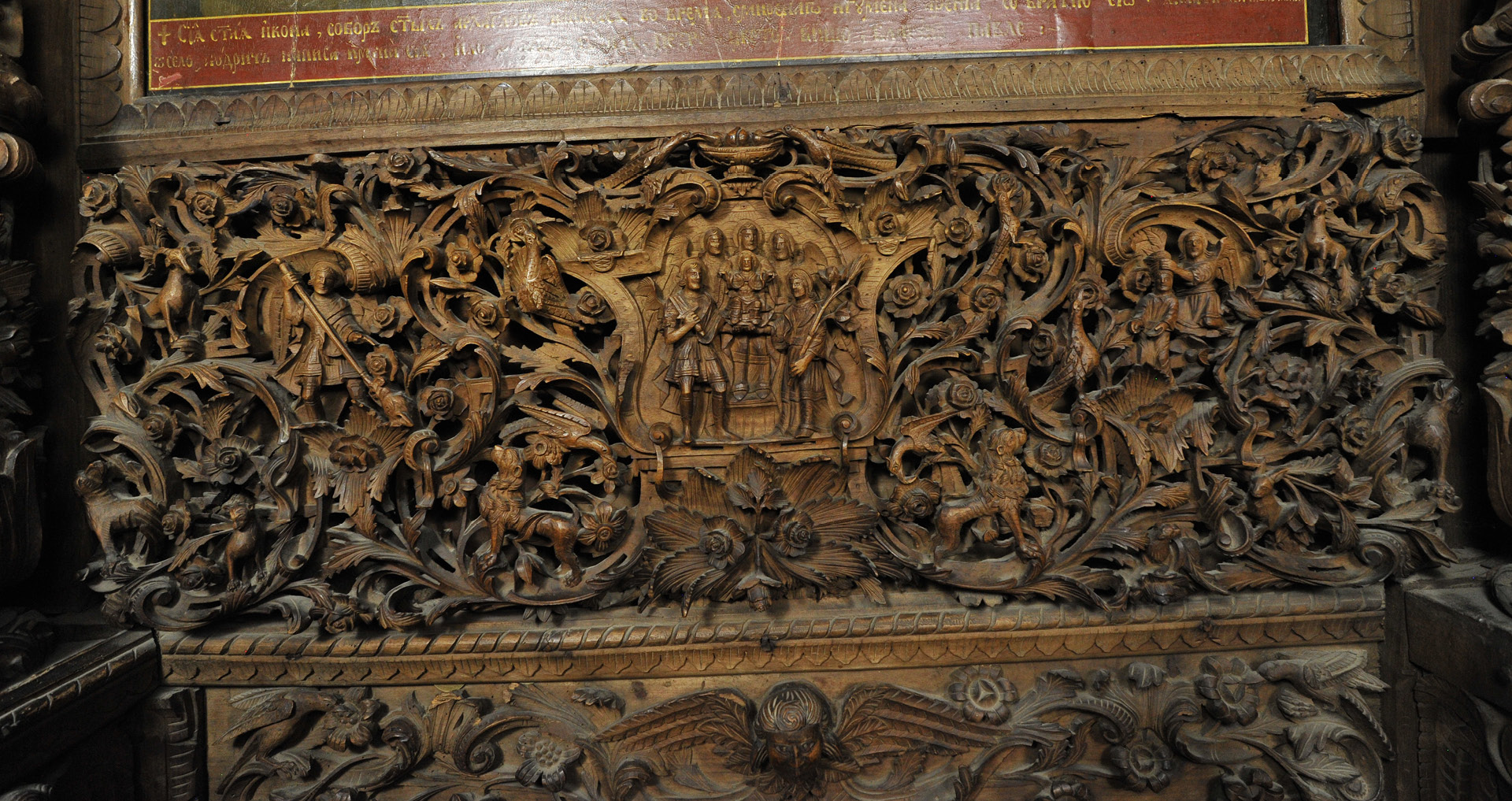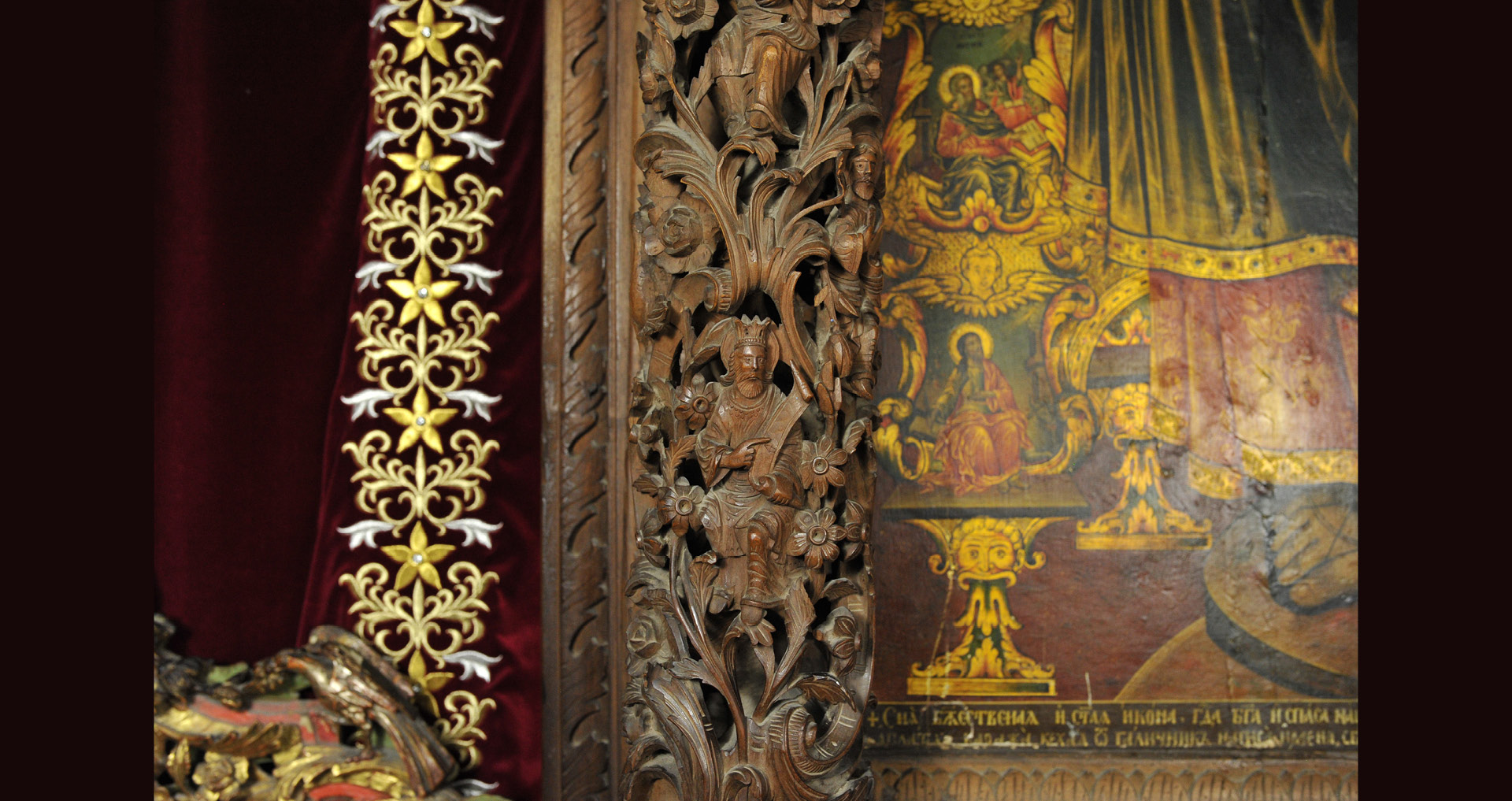The Iconostasis
Abbot Arsenius began his work on the interior and exterior decoration of the church in 1810. By the end of his life, he would become the most renowned superior of this monastery, due to his engaging of iconographers and icon painters. Especially because of the engagement of the best Miyak wood carvers, who have carved the iconostasis, as well as the Bishop’s and the superior’s throne, intended for the church.
The most beautiful adornment in the church, the one this monastery is most famous for, is certainly the magnificent iconostasis, unique of this kind in the Orthodoxy and a masterpiece of the Miyak woodcarvers, who have, up to present day, remained unequalled in their remarkable skill of woodcarving. They are the well renowned Petre and Marko Filipovski – Garkata, from the village Gari, with his group and Makarios Frchkovski from Galicnik. They have completed this monumental work for a surprisingly short period of time, from 1830 till 1835. At the same time, Michael and his son monk Daniele painted the icons for the iconostasis, so that, all together with the icons, it represents a whole, a complete presentation of the Holy Bible in carving and paint. What makes this iconostasis unique and unrepeatable is the use of human figures. This is where the Miyak woodcarvers have shown all their skill, placing, in such limited space, a significant number of scenes from the Old and New Testament. These scenes are presented in such way that all the dramatic nature of the situation is conveyed to us as if real and alive, as if happening right before our eyes.
According to its architecture the iconostasis is similar to the two-storey iconostases, which at first we encounter on the Mount Athos (Holy Mountain), but they can also be found on the Balkan Peninsula. The Abbot Arsenios had a wish and his wish was to give to the monastery an iconostasis which will be one of the best ever made until then and unique of its kind. Therefore he decided to hire the best Miyak wood carvers and the best fresco painters of that time, which contributed to the fact that the iconostasis simply surpassed all the other with its uniqueness. Damian Arsov, a former resident of Debar who had rounded the whole Mount Athos in 1895 confirms this whit his statement: “that there was no other monastery on the Mount Athos with an iconostasis similar to the one in the Bigorski monastery.
What makes the iconostasis unique and unrepeatable is the use of human figure. This is where the Miyak woodcarvers have shown all their skill, placing, in such limited space, a significant number of scenes from the Old and New Testament. These scenes are presented in such way that all the dramatic nature of the situation is conveyed to us as if real and alive, as if happening right before our eyes.
Besides the human figure, there are also various animals and floral motifs included in the decoration of the iconostasis. This mixture is realized in such a pleasant harmony, through the previously prepared drawings and design of the Miyak carvers. Their patience to carve the wood and make so many scenes from Holy Bible in a such small space also awakens the admiration of every visitor. What these carvers have created cannot be found neither on the Mount Athos nor at the Epirus carvers and not even in the work of the carvers from the Balkan woodcarving schools. The iconostasis is adequate to the dimensions of the church. Therefore there are three rows of icons, which present an uniqueness as well, because there are often encountered iconostasis with only two rows of icons. It resembles to the Mount Athos iconostasis from the XIX century with central placed royal gates and two side entrances on the southern and northern side. The royal gates are two-winded and ornately with carvings and icon painting with a presentation of the “Annunciation” in the middle. Alongside the “Annunciation” the wood carvers have made a composition from the life of Jesus Christ, then one scene of His miracles – “Healing the blind man from Bethsaida” and as well as the “”Cleansing of the Temple”.
The xylographic rectangular panels under the throne icons are the most beautiful fragment of the iconostasis in the Bigorski monastery. All the virtuosity of the Miyak wood-carvers is confirmed on these boards, as well as their unattainability in woodcarving. There are more than 500 human figures and around 200 animal figures presented on these panels, and they illustrate the entire Old and New Testament. From the Old Testament we can select the presentation of “Abraham’s Sacrifice of Isaac”, “The Ancestral sin”, “The Expulsion from the Garden of Eden”, “The Murder of Cain” etc. The New Testament presentation starts from the second table where the life of the Most Holy Theotokos is presented. It seems that, while working on the iconostasis, the Miyak craftsmen of the woodcarving group of Petre Frchkovski wanted to express all their gratitude and gratefulness towards the Holy Mother of God – Theotocos, by produsing as many as 14 scenes from Her life. On the second table is the Holy Mother of God with Christ. On the left is “The Annunciation” and on the right is the presentation of “The Three Magi” bringing gifts for the newborn baby Jesus and venerating Theotocos. Here we have a very impressive presentation of “The Flight to Egypt”. In this scene, the expression of their faces shows the psychological element in the drama of Betlehem children killed at the order of King Herod.
On the next tables the life and sufferings of our God Jesus Christ are presented. In the centre is ” The Last Supper”, to the left is “The Bargain of Judas”, The Gethsemane Prayer”, and on the right is “The Way to Golgotha”, “Doubting Thomas”, “Jesus before Pilate”, etc.
Beneath the main icon of St. John the Baptist are scenes from his life. Here you can see “the Birth of St. John”, “Herod’s birthday”, “Salome’s Dance” and other scenes among which the most beautiful is “The Beheading of St. John”.
On the place beneath the main icon of The Gathering of the Apostles in Tiberias”, the woodcarvers made their own presentation of this icon carved in wood. On the carvings, Christ is presented among the diciples with a model of the church held by two angels, with St. Peter and Paul in front like founders of the Church. All the icons have their own woodcarved presentation right beneath them.
The top of the iconostasis is one of the most impressive parts and it is decorated with a great cross from the Crucifixion and its accompanying parts. This type of cross is typical for the carved iconosasis from the post-byzantine period, especially from the XVII, XVIII, and XIXc being a symbol of faith, salvation and victory. The golden dragons beneath the cross represent the evil destroyed by Christ.
The Miraculous icon of St. John
The icon itself and the face of St John, radiates not only holy grace, as a gift from the presence of the Holy Spirit, but also an uncreated and unvanishing light which brings peace, calmness and joy. Everyone can feel this when one stands in front of this miraculous icon of the Forerrunner who with meek dignity is expecting all the pilgrims that come to the Bigorski monastery. Radiating in a silver shining armor and abundantly decorated with gifts of gratitude, because of the numberless miracles, the icon itself, like an inexhaustible source radiates miraculous grace. For that reason the monks that lived in the monastery in XIXc, on the armor of the icon added one more hand as an evidence and memory of the miracles of st. John until the present times.
One of the miracles is the way the icon revealed itself to the John, the founder. According to the tradition of the monastery, the icon was simply floating in the air above the water source, on this very place today there are three sources of water situated under the church. It was miraculous how, the icon was disappearing during the restless and difficult times the monastery was experiencing. The holy grace that the icon carries in itself, preserved it from destruction and vanish during the several time of devastation of the monastery. The icon reappeared every time, testifying for the eternally living spirit of the monastery recreating itself like a phoenix from its ruins.
Thus, from the very beginning, the icon didn’t stop making miracles. Numerous pilgrims and visitors who stood in prayer in front of the icon with faith and open heart, were comforted and healed from deceases. The Forerunner, through his icon sent his help to everyone: young and old, healthy and sick, orthodox and heterodox. As the miracles increased, so the gifts on the icons became numerous. Every gift on the icon hides a true story behind itself. Innumerable silver medallions in the shape of a small baby, testify how childless parents were gifted with children by St. John.
As the silver armor covers the icon, so had St. John hidden from us many of his numerous miracles, humbly showing only a part of the miracles, that the new brotherhood made efforts to record and preserve, as a proof for the holiness of the icon.
The icon It is truly meet

On the northern side of the church soleas, just in front of the iconostasis, you will encounter the meek and serene image of the Most Holy Theotokos. Her icon is a true copy of the icon Axion Estin – It is truly meet – the greatest treasure of Mount Athos. Due to the sincere desire and effort of Archimandrite Parthenius, this icon was painted in 2009 and brought to the monastery, but not before it was taken to Mount Athos where it has been blessed by the original icon.
Моштите
The grace in the church is enriched by the presence of the holy relics of the numerous citizens of the Heavenly Kingdom, placed in a very decorative reliquary, which dates back to 1833. Beside these there are many relics kept in the altar on the Holy Table. The reliquary was commissioned by Abbot Arsenius and it is a mutual work of art of a painter, wood carver and filigree craftsman. On the cover of the exterior part of the reliquary, in a medallion of forged silver is the Crucifixion of Christ with the Holy Mother and St. John, while on the inner side of the reliquary, the painters Michael and Daniel painted the images of the saints whose relics are placed in the reliquary. The images of the saints are also engraved in a silver filigree inside the reliquary. There one can see the relics of St. John the Baptist, which are myrrh-bearing and healing, as well as those of St. Marina, St. Paraskeva, St. Eustathios, St. Pantaleon, St. James the Righteous, St Cyricus and Julitta, St. Triphon, St. Charalambos and St. Nicetas. In the middle of the reliquary a big silver cross is engraved, containing the particle from the Holy Cross of our Lord Jesus Christ. These holy relics were brought from Constantinople and were presented to the monastery by the rich merchant Hadji Nake from the village of Belichica.

In addition, in the altar, the relics of St. Clement of Ohrid, St. Stephen, St. Nicholas of Myrrh, St. Seraphim of Sarov, St. John the Russian, St. Barbara, St. Lazarus of Bethany, St. Clement of Rome, St. Agathangelus of Bitola, St. Nectarios of Aegina and many others are kept.
These relics are an invaluable treasure of the monastery and because of them, all these saints are present in the church with their prayers and grace, thus becoming intercessors before God for the monks and laymen who approach their relics with faith to venerate them. Because the holy relics going through the holy fire of martyrdom and feat, converted into a real treasure of the Great and Living God. The deified relics of the saints are the foundations of the Holy Church of Christ.


